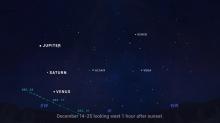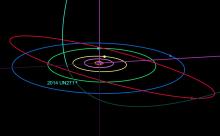Listen to today's episode of StarDate on the web the same day it airs in high-quality streaming audio without any extra ads or announcements. Choose a $8 one-month pass, or listen every day for a year for just $30.
You are here
Lyrid Meteor Shower
A “skinny” meteor shower should be at its best tonight. The Lyrid shower turns up every year at this time, and has for at least 2700 years. But the number of meteors is pretty low — about 10 to 20 per hour. In part, that’s because the object that supplies the Lyrids is a long way away.
Lyrid meteors are bits of debris from Comet C/1861 G1 Thatcher. When the comet comes near the Sun, some of its ice vaporizes. That releases bits of rock and dirt into space. Over time, they spread out along the comet’s orbit. Earth flies through that trail of comet dust every April. Some of the particles ram into the atmosphere and vaporize, forming meteors.
A meteor shower is most intense around the time its parent body is closest to the Sun, when it releases fresh debris into space. For Comet Thatcher, that last happened in 1861 — the year it was discovered. Today, the comet is about 10 billion miles from the Sun and moving outward. It’ll be farthest in a few decades. Then it’ll turn around and head sunward, with its closest approach around the year 2276 — when skywatchers may see some great displays of Lyrid meteors.
For now, check out the shower beginning in late evening, as the meteor stream begins to rotate into view. The window is short because the Moon will rise about 2 or 2:30. Its glare will overpower all but the brightest meteors — the offspring of a far-away comet.
Script by Damond Benningfield






